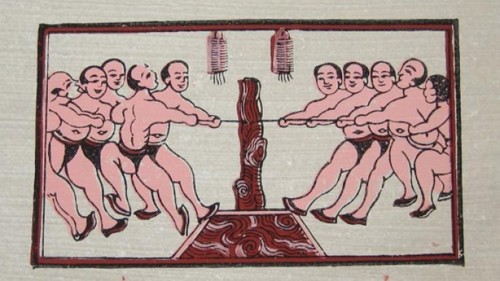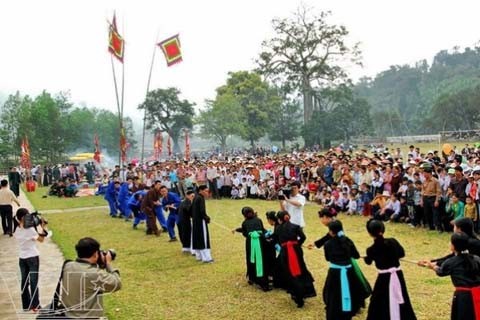(VOVworld)- Vietnam has completed a dossier on “Rituals and Tug of War folk games” to seek UNESCO recognition as an intangible cultural heritage of humanity by 2015. Vietnam has joined the Republic of Korea, Cambodia and the Philippines to submit a multinational dossier about their traditional tug-of-war games. This has helped promote Vietnamese culture and strengthen cultural exchanges between Vietnam and other regional countries.
 |
| Tug of war games in Dong Ho paintings. (Photo: VOV) |
Late last year, the Ministry of Culture, Sports and Tourism decided to compile a multi-national dossier about traditional Tug of war games to seek UNESCO recognition as an Intangible Cultural Heritage of humanity. This was the first time that Vietnam had coordinated with other countries to compile a multi-national dossier, which is expected to be approved by UNESCO by 2015. Tug of war is a folk game that appeared in Vietnam long ago and is often organized during spring festivals to pray for favourable weather, a good crop, happiness and prosperity. The tug of war game represents the strength and unity of farmers. Professor Ngo Duc Thinh, a member of the National Cultural Heritage Council said: “It is not only a game, but also a spiritual competition. After winning the game, the winners go to the Communal House and Temple to worship the Genie who, according to their belief, blesses them and their friends to win the reward and honour. So, in addition to being entertaining, folk games reflect the people’s traditional customs and spirits”.
At the festival of Huu Chap village in Hoa Long commune, Bac Ninh, Tug of war game has become an official ritual of the festival. According to legends, local people wanted to find strong people to build houses and communal houses, so they organized a competition of pulling timber rafts, which later became the tug of war game. Huu Chap village’s festival of tug of war takes place on the 4th day of the first lunar month. It has been organized in the village for nearly 400 years. The festival begins with a solemn procession, a worshipping ceremony and a ceremony to recall the village’s history and tradition. Nguyen Van Chuan, Head of the village’s Elderly Association says that tug of war is the most exciting event in the festival: “Ropes are often used in tug of war, but people in Huu Chap village connect two bamboo trees and pull on shoulder poles to show their strength. It takes people in the village months to prepare for the game. They have to find strong bamboo trees. It is an honor for a family whose bamboo trees are selected for the game. It is also an honor for those who are selected to play”.
 |
| Huu Chap men show their strength in the game. (Photo: VNA) |
Traditionally, 70 strong men are equally divided into two teams- the East and the West- to play. They have to play three rounds and whoever wins two rounds is the winner. However, the East team always wins because according to custom, if the East team wins, local people will earn a bumper crop. So, the audience always tries to help the East team to win the game and as a result, the festival ends in fun.
Tug of war is also very popular among other ethnic groups around Vietnam. Ropes made of different materials, wooden sticks and even hands are used in the game. The rules of the game also vary in different regions but above all, the game represents strength and unity. Thao Giang, a folklore researcher, says: “Tug of war is also popular in other countries but the way that Vietnamese people have played the game, which is reflected in many folk paintings, shows that through the game, Vietnamese people want to practice to become stronger. It is a non-violent game. Wining or losing is not important. The game is just fun”.
In modern society, tug of war remains a popular game, especially among students and workers. Seeking UNESCO recognition for the Tug of war ritual and game as an intangible cultural heritage of the humanity will give Vietnam a chance to further promote this ancient folk game.
 |
| Ethnic people in Tuyen Quang province enjoy tug of war games. (Photo: VNA) |